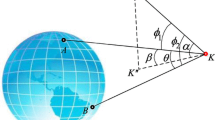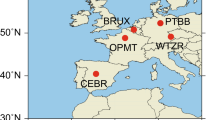Abstract
GPS precise point positioning (PPP) technique has been widely used in time and frequency transfer. The performance of PPP can be improved if the phase ambiguities are fixed to the correct integer number. In this study, GPS PPP integer ambiguity resolution (PPP AR) with CNES/CLS products is applied in time and frequency transfer. To eliminate the day boundary discontinuities and achieve continuous time and frequency transfer with GPS PPP AR, a method of modified satellites carrier phase continuity is proposed when multi-day GPS PPP AR solutions are calculated. In addition, to guarantee the robustness of time transfer results, a three-segment factor is used to adjust the variance of integer ambiguities constraints. Test results in comparison of PPP AR with an optical time link show that standard deviation is deduced about 40% and the frequency stability is improved about 50% for 3.5d averaging than BIPM PPP method. Besides, GPS PPP AR shows a better short-term frequency stability than BIPM IPPP while they show similar STD value and long-term frequency stability. Moreover, test results with zero-baseline, short-baseline and long-baseline time transfer links show that the average frequency stability improvement rates are about 40% compared with PPP float solutions, and about 30% compared with IGS final products when the averaging time is 21.3 h.











Similar content being viewed by others
Data availability
The raw GPS data and the precise products can be accessed at ftp://cddis.gsfc.nasa.gov.
References
Böhm J, Niell A, Tregoning P, Schuh H (2006) Global mapping function (GMF): a new empirical mapping function based on numerical weather model data. Geophys Res Lett. https://doi.org/10.1029/2005GL025546
Cao X, Yu X, Ge Y, Liu T, Shen F (2022) BDS-3/GNSS multi-frequency precise point positioning ambiguity resolution using observable-specific signal bias. Measurement 195:111134. https://doi.org/10.1016/j.measurement.2022.111134
Chen C, Xiao G, Chang G, Xu T, Yang L (2021) Assessment of GPS/Galileo/BDS precise point positioning with ambiguity resolution using products from different analysis centers. Remote Sens 13(16):3266. https://doi.org/10.3390/rs13163266
Dach R, Schildknecht T, Hugentobler U, Bernier L, Dudle G (2006) Continuous geodetic time-transfer analysis methods. IEEE Trans Ultrason Ferroelectr Freq Control 53(7):1250–1259. https://doi.org/10.1109/TUFFC.2006.1665073
Defraigne P, Bruyninx C (2007) On the link between GPS pseudorange noise and day-boundary discontinuities in geodetic time transfer solutions. GPS Solut 11(4):239–249. https://doi.org/10.1007/s10291-007-0054-z
Delporte J, Mercier F, Laurichesse D, Galy O (2015) GPS carrier-phase time transfer using single-difference integer ambiguity resolution. Int J Navig Obs 2008:1–7. https://doi.org/10.1155/2008/273785
Duan B, Hugentobler U (2021) Comparisons of CODE and CNES/CLS GPS satellite bias products and applications in Sentinel-3 satellite precise orbit determination. GPS Solut 25(4):1–11. https://doi.org/10.1007/s10291-021-01164-5
Ge M, Gendt G, Rothacher M, Shi C, Liu J (2008) Resolution of GPS carrier-phase ambiguities in precise point positioning (PPP) with daily observations. J Geodesy 82(7):389–399. https://doi.org/10.1007/s00190-007-0187-4
Ge Y, Zhou F, Dai P, Qin W, Wang S, Yang X (2019) Precise point positioning time transfer with multi-GNSS single-frequency observations. Measurement 146:628–642. https://doi.org/10.1016/j.measurement.2019.07.009
Geng J, Meng X, Dodson A, Teferle F (2010) Integer ambiguity resolution in precise point positioning: method comparison. J Geodesy 84(9):569–581. https://doi.org/10.1007/s00190-010-0399-x
Hatch R (1982) The Synergism of GPS Code and Carrier Measurements. In: Proceedings of the third international symposium on satellite doppler positioning at physical sciences laboratory of new Mexico State university, Feb. 8–12, Vol. 2, pp 1213–1231
Kouba J, Héroux P (2001) Precise point positioning using IGS orbit and clock products. GPS Solut 5(2):12–28. https://doi.org/10.1007/PL00012883
Lagler K, Schindelegger M, Böhm J, Krásná H, Nilsson T (2013) GPT2: empirical slant delay model for radio space geodetic techniques. Geophys Res Lett 40(6):1069–1073. https://doi.org/10.1002/grl.50288
Laurichesse D, Mercier F, Berthias JP, Broca P, Cerri L (2009) Integer ambiguity resolution on undifferenced GPS phase measurements and its application to PPP and satellite precise orbit determination. J Inst Navig 56(2):135–149. https://doi.org/10.1002/j.2161-4296.2009.tb01750.x
Loyer S, Perosanz F, Mercier F, Capdeville H, Marty J (2012) Zero-difference GPS ambiguity resolution at CNES–CLS IGS analysis Center. J Geodesy 86(11):991–1003. https://doi.org/10.1007/s00190-012-0559-2
Lyu D, Zeng F, Ouyang X, Zhang H (2020) Real-time clock comparison and monitoring with multi-GNSS precise point positioning: GPS, GLONASS and Galileo. Adv Space Res 65(1):560–571. https://doi.org/10.1016/j.asr.2019.10.029
Montenbruck O, Hackel S, Jaggi A (2018) Precise orbit determination of the sentinel-3A altimetry satellite using ambiguity-fixed GPS carrier phase observations. J Geodesy 92(7):711–726
Petit G (2021) Sub-10–16 accuracy GNSS frequency transfer with IPPP. GPS Solut 25(1):1–9. https://doi.org/10.1007/s10291-020-01062-2
Petit G, Jiang Z (2007) Precise point positioning for TAI computation. In: 2007 IEEE international frequency control symposium joint with the 21st European frequency and time forum. pp 395–398
Petit G, Kanj A, Loyer S, Delporte J, Mercier F, Perosanz F (2015) 1×10−16frequency transfer by GPS PPP with integer ambiguity resolution. Metrologia. https://doi.org/10.1088/0026-1394/52/2/301/
Shi J, Gao Y (2014) A comparison of three PPP integer ambiguity resolution methods. GPS Solut 18(4):519–528. https://doi.org/10.1007/s10291-013-0348-2
Śliwczyński Ł, Krehlik P, Czubla A, Buczek Ł, Lipiński M (2013) Dissemination of time and RF frequency via a stabilized fibre optic link over a distance of 420 km[J]. Metrologia 50(2):133–145. https://doi.org/10.1088/0026-1394/50/2/133
Teunissen PJ, De Jonge P, Tiberius C (1997) Performance of the LAMBDA method for fast GPS ambiguity resolution. Navigation 44(3):373–383. https://doi.org/10.1002/j.2161-4296.1997.tb02355.x
Xu W, Shen W, Cai C, Li L, Wang L, Ning A, Shen Z (2022) Comparison and evaluation of carrier phase PPP and single difference time transfer with multi-GNSS ambiguity resolution. GPS Solut 26(2):1–18. https://doi.org/10.1007/s10291-022-01242-2
Yang Y (1994) Robust estimation for dependent observation. Manuscripta Geod 19:10–17
Yang Y, Song L, Xu T (2002) Robust estimator for correlated observations based on bifactor equivalent weights. J Geodesy 76(6):353–358. https://doi.org/10.1007/s00190-002-0256-7
Yao J, Skakun I, Jiang Z, Levine J (2015) A detailed comparison of two continuous GPS carrier-phase time transfer techniques. Metrologia 52(5):666. https://doi.org/10.1088/0026-1394/52/5/666
Yao J, Levine J (2013) A new algorithm to eliminate GPS carrier-phase time transfer boundary discontinuity. In: Proceedings of the 45th annual precise time and time interval systems and applications meeting. pp 292–303
Acknowledgements
The authors thank Jerzy Nawrocki at AOS and Albin Czubla at GUM for providing the fiber link data and the GPS data. BIPM is gratefully acknowledged for providing the time comparison results. The authors would like to thank IGS for the GPS data. We also acknowledge CNES/CLS for providing precise products. This research was supported by the Science and Technology Innovation Program of Hunan Province (No. 2021RC3073), Natural Science Foundation of Hunan Province (No. 2021JJ40665) and the National Natural Science Foundation of China (No. 42204039 and No. 42104014). We would like to thank National Ministries (No. 2019-JCJQ-JJ-190), who supported the work.
Funding
This research was supported by the Science and Technology Innovation Program of Hunan Province (No. 2021RC3073), Natural Science Foun dation of Hunan Province (No. 2021JJ40665) and the National Natural Science Foundation of China No. 42204039 and No. 42104014 ). We would like to thank National Ministries (No. 2019 JCJQ JJ 190), who supported the work.
Author information
Authors and Affiliations
Contributions
All authors contributed to the study conception and design. ZR and DL designed the experiments. ZR performed the experiments, analyzed the data, and wrote the paper. HG, JP, XH and GS contributed to discussions and revisions. All authors reviewed and approved the manuscript.
Corresponding author
Ethics declarations
Conflict of interest
The authors declare no competing interests.
Additional information
Publisher's Note
Springer Nature remains neutral with regard to jurisdictional claims in published maps and institutional affiliations.
Rights and permissions
Springer Nature or its licensor (e.g. a society or other partner) holds exclusive rights to this article under a publishing agreement with the author(s) or other rightsholder(s); author self-archiving of the accepted manuscript version of this article is solely governed by the terms of such publishing agreement and applicable law.
About this article
Cite this article
Ren, Z., Lyu, D., Gong, H. et al. Continuous time and frequency transfer using robust GPS PPP integer ambiguity resolution method. GPS Solut 27, 82 (2023). https://doi.org/10.1007/s10291-023-01420-w
Received:
Accepted:
Published:
DOI: https://doi.org/10.1007/s10291-023-01420-w




